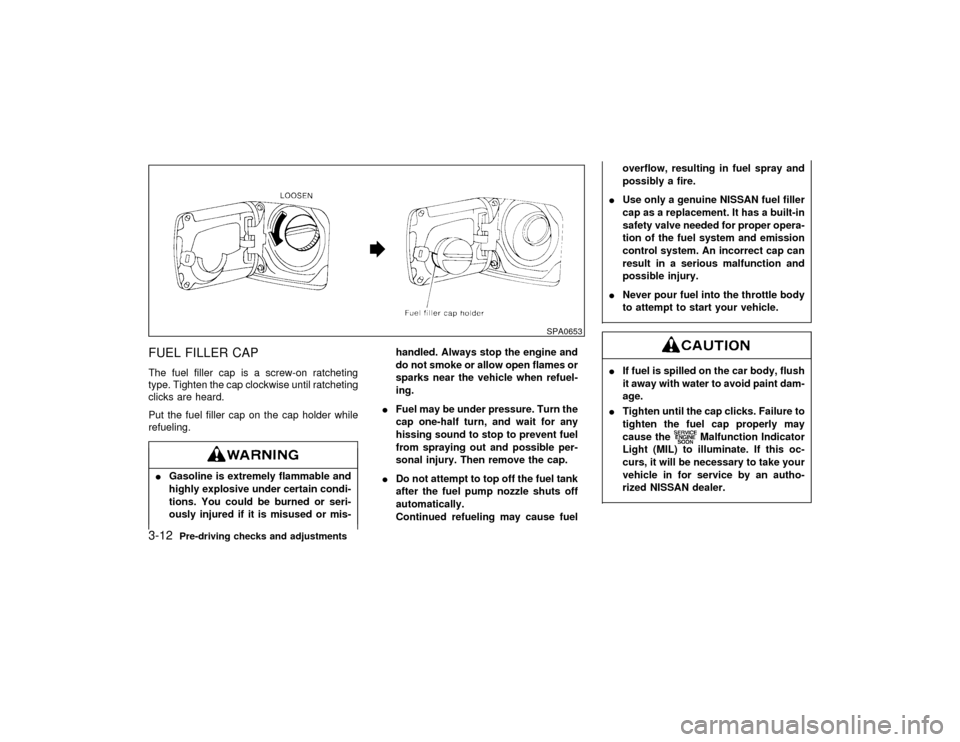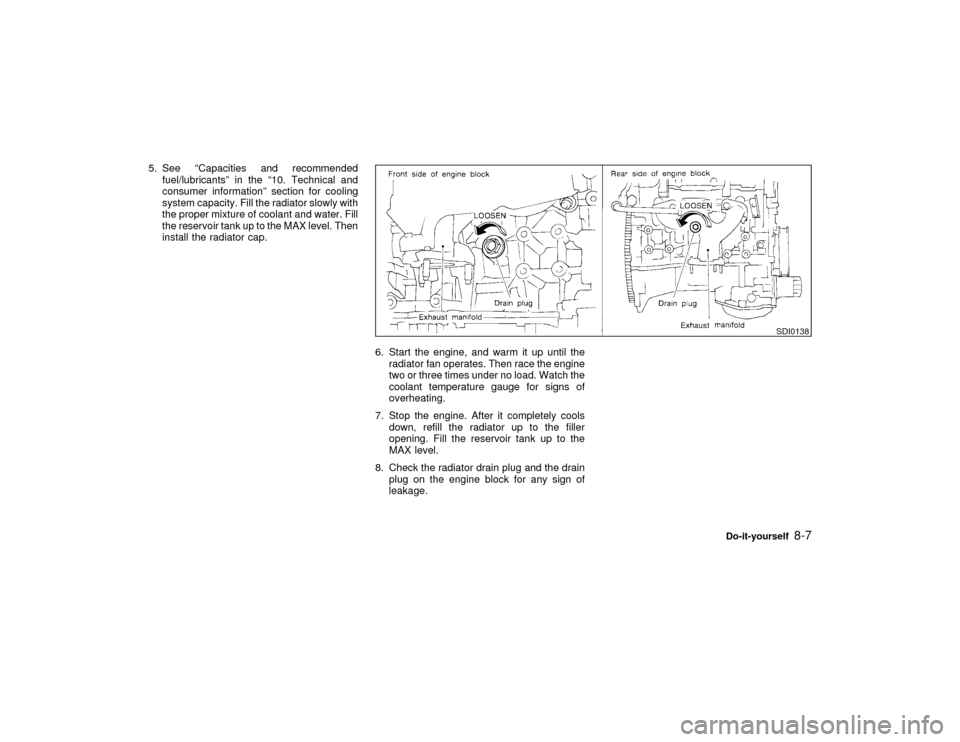1998 NISSAN MAXIMA fuel cap
[x] Cancel search: fuel capPage 55 of 231

Turn signal/hazard indicator
lights
The light flashes when the turn signal switch
lever or hazard switch is turned on.
High beam indicator light
(Blue)
This light comes on when the headlight high
beam is on and goes out when the low beam is
selected.
Cruise indicator light
The light comes on while the vehicle speed is
controlled by the cruise control system. If the
light flickers while the engine is running, it may
indicate there is something wrong with the
cruise control system. Have the system
checked by your NISSAN dealer.
Malfunction indicator light
(MIL)
If the malfunction indicator light comes on
steady or blinks while the engine is running, it
may indicate a potential emission control prob-
lem.
The malfunction indicator light will come on in
one of two ways:
IMalfunction indicator light on steady Ð Anemission control system malfunction has
been detected. Have the vehicle inspected
by an authorized NISSAN dealer. You do
not need to have your vehicle towed to the
dealer.
IMalfunction indicator light blinking Ð An
engine misfire has been detected which
may damage the emission control system.
To reduce or avoid emission control system
damage:
a) Do not drive at speeds above 45 MPH
(72 km/h).
b) Avoid hard acceleration or deceleration.
c) Avoid steep uphill grades.
d) If possible, reduce the amount of cargo
being hauled or towed.
The malfunction indicator light may stop
blinking and come on steady.
Have the vehicle inspected by an autho-
rized NISSAN dealer. You do not need to
have your vehicle towed to the dealer.
Continued vehicle operation without
having the emission control system
checked and repaired as necessary
could lead to poor driveability, reduced
fuel economy, and possible damage to
the emission control system.Some conditions may cause the malfunction
indicator light to come on steady or blink.
Examples are as follows:
Ivehicle ran out of fuel, which caused the
engine to misfire.
Ifuel filler cap was left off or improperly
installed, allowing fuel to evaporate into the
atmosphere.
If you suspect that you experienced one or
both of the above conditions, drive the vehicle
to an authorized NISSAN dealer and have the
vehicle inspected. Avoid any unnecessary di-
agnosis during the service by informing the
dealer of the conditions listed above that may
have occurred.
2-10
Instruments and controls
Z
01.1.31/A32-D
X
Page 87 of 231

FUEL FILLER CAPThe fuel filler cap is a screw-on ratcheting
type. Tighten the cap clockwise until ratcheting
clicks are heard.
Put the fuel filler cap on the cap holder while
refueling.IGasoline is extremely flammable and
highly explosive under certain condi-
tions. You could be burned or seri-
ously injured if it is misused or mis-handled. Always stop the engine and
do not smoke or allow open flames or
sparks near the vehicle when refuel-
ing.
IFuel may be under pressure. Turn the
cap one-half turn, and wait for any
hissing sound to stop to prevent fuel
from spraying out and possible per-
sonal injury. Then remove the cap.
IDo not attempt to top off the fuel tank
after the fuel pump nozzle shuts off
automatically.
Continued refueling may cause fueloverflow, resulting in fuel spray and
possibly a fire.
IUse only a genuine NISSAN fuel filler
cap as a replacement. It has a built-in
safety valve needed for proper opera-
tion of the fuel system and emission
control system. An incorrect cap can
result in a serious malfunction and
possible injury.
INever pour fuel into the throttle body
to attempt to start your vehicle.
IIf fuel is spilled on the car body, flush
it away with water to avoid paint dam-
age.
ITighten until the cap clicks. Failure to
tighten the fuel cap properly may
cause the
Malfunction Indicator
Light (MIL) to illuminate. If this oc-
curs, it will be necessary to take your
vehicle in for service by an autho-
rized NISSAN dealer.
SPA0653
3-12
Pre-driving checks and adjustments
Z
01.1.31/A32-D
X
Page 101 of 231

The air conditioning system in your NISSAN
vehicle is charged with a refrigerant designed
with the environment in mind.This refrigerant
will not harm the earth's ozone layer.How-
ever, special charging equipment and lubricant
are required when servicing your NISSAN air
conditioner. Using improper refrigerants or lu-
bricants will cause severe damage to your air
conditioning system. See ªCapacities and rec-
ommended fuel/lubricantsº in the ª10. Techni-
cal and consumer informationº section for air
conditioning system refrigerant and lubricant
recommendations.
Your NISSAN dealer will be able to service
your environmentally friendly air conditioning
system.The air conditioner system contains re-
frigerant under high pressure. To avoid
personal injury, any air conditioner ser-
vice should be done only by an experi-
enced technician with proper
equipment.
RADIOTo turn the radio on, turn the ignition key to
ACC or ON. If you listen to the radio with the
engine not running, turn the key to the ACC
position.
Radio reception is affected by station signal
strength, distance from radio transmitter, build-
ings, bridges, mountains and other external
influences. Intermittent changes in reception
quality normally are caused by these external
influences.
SERVICING AIR CONDITIONER AUDIO SYSTEM4-12
Heater, air conditioner and audio systems
Z
01.1.31/A32-D
X
Page 162 of 231

5. See ªCapacities and recommended
fuel/lubricantsº in the ª10. Technical and
consumer informationº section for cooling
system capacity. Fill the radiator slowly with
the proper mixture of coolant and water. Fill
the reservoir tank up to the MAX level. Then
install the radiator cap.
6. Start the engine, and warm it up until the
radiator fan operates. Then race the engine
two or three times under no load. Watch the
coolant temperature gauge for signs of
overheating.
7. Stop the engine. After it completely cools
down, refill the radiator up to the filler
opening. Fill the reservoir tank up to the
MAX level.
8. Check the radiator drain plug and the drain
plug on the engine block for any sign of
leakage.
SDI0138
Do-it-yourself
8-7
Z
01.1.31/A32-D
X
Page 164 of 231

CHANGING ENGINE OIL1. Park the vehicle on a level surface and
apply the parking brake.
2. Run the engine until it reaches operating
temperature.
3. Turn the engine off and wait more than 10
minutes.
4. Place a large drain pan under the drain
plug.
5. Remove the oil filler cap.6. Remove the drain plug with a wrench and
completely drain the oil.
If oil filter is to be changed, remove and
replace it at this time. See later in ªEngine
oilº for changing engine oil filter.
Be careful not to burn yourself, as the
engine oil is hot.Waste oil must be disposed of properly.
Check your local regulations.
7. Clean and re-install the drain plug and new
washer. Securely tighten the drain plug with
a wrench.
Drain plug tightening torque:
22 to 29 ft-lb
(29 to 39 N×m)
Do not use excessive force.
8. Refill engine with recommended oil and
install the cap securely.
See ªCapacities and recommended
fuel/lubricantsº in the ª10. Technical and
consumer informationº section for refill ca-
pacity.9. Start the engine.
Check for leakage around the drain plug.
Correct as required.
10.Turn the engine off and wait more than 10
minutes. Check the oil level with the dip-
stick. Add engine oil if necessary.
11.Dispose of waste oil in the proper manner.
IProlonged and repeated contact with
used engine oil may cause skin can-
cer.
ITry to avoid direct skin contact with
used oil. If skin contact is made, wash
thoroughly with soap or hand cleaner
as soon as possible.
IKeep used engine oil out of reach of
children.
SDI0139
Do-it-yourself
8-9
Z
01.1.31/A32-D
X
Page 204 of 231

10 Technical and consumer informationCapacities and recommended
fuel/lubricants .......................................................... 10-2
Specifications .......................................................... 10-7
When traveling or registering your
vehicle in another country ....................................... 10-9
Vehicle identification ............................................... 10-9
Installing front license plate................................... 10-11
Vehicle loading information ................................... 10-12
Towing a trailer ..................................................... 10-13
Uniform tire quality grading ................................... 10-17
Emission control system warranty ........................ 10-18
Reporting safety defects (US only) ....................... 10-18
Readiness for inspection/maintenance
(I/M) test (US only) ................................................ 10-18
Z
01.1.31/A32-D
X
Page 205 of 231

The following are approximate capacities. The actual refill capacities may be a little
different. When refilling, follow the procedure instructed in the ª8. Do-it-yourselfº section
to determine the proper refill capacity.
Capacity (Approximate)
Recommended
specifications US
measureImp
measureLiter
Fuel 18-1/2 gal 15-3/8 gal 70Unleaded gasoline with an octane rating
of at least 91 AKI (RON 96)
Engine oil (Refill)
With oil filter 4-1/4 qt 3-1/2 qt 4.0IAPI SG or SH and Energy Conserving
II*1, *2
IAPI Certification Mark*1, *2 Without oil filter 3-7/8 qt 3-1/4 qt 3.7
Cooling system
With reservoir 9 qt 7-1/2 qt 8.5
Anti-freeze coolant
(Ethylene glycol base)
Reservoir 7/8 qt 3/4 qt 0.8
Manual transmission gear oilÐ Ð Ð API GL-4, Viscosity SAE 80W-90 only
Automatic transmission fluid
Refill to the proper oil level according
to the instructions in the ª8. Do-it-
yourselfº section.Nissan Matic ªDº (Continental U.S. and
Alaska) or Genuine Nissan Automatic
Transmission Fluid (Canada).*3
Power steering fluid Type DEXRON
TMIII or equivalent
Brake and clutch fluidGenuine Nissan Brake Fluid*4 or equiva-
lent DOT 3 (US FMVSS No. 116)
Multi-purpose greaseÐ Ð Ð NLGI No. 2 (Lithium soap base)
Air conditioning system refrigerantÐ Ð Ð HFC-134a (R-134a)
Air conditioning system lubricants Ð Ð ÐNissan A/C System Oil
Type S or exact equivalent
*1: For additional information, see later in ªCapacities and recommended fuel/lubricantsº for engine oil and oil filter recommendation.
*2: For additional information, see later in ªCapacities and recommended fuel/lubricantsº for recommended SAE viscosity number.
*3: Dexron
TMIII/Mercon
TMor equivalent may also be used. Outside the continental United States and Alaska contact a NISSAN dealer for
more information regarding suitable fluids, including recommended brand(s) of Dexron
TMIII/Mercon
TMautomatic transmission fluid.
*4: Available in mainland US through your NISSAN.
FUEL RECOMMENDATIONUnleaded premium gasoline with an octane
rating of at least 91 AKI (Anti-Knock Index)
number (Research octane number 96)
If unleaded premium gasoline is not avail-
able, unleaded regular gasoline with an
octane rating of at least 87 AKI (Research
octane number 91) can be used.
However, for maximum vehicle perfor-
mance, the use of unleaded premium gaso-
line is recommended.Using a fuel other than that specified
could adversely affect the emission con-
trol devices and systems, and could
also affect the warranty coverage.
Under no circumstances should a
leaded gasoline be used, since this will
damage the three-way catalyst.Reformulated gasolineSome fuel suppliers are now producing refor-
mulated gasolines. These gasolines are spe-
cially designed to reduce vehicle emissions.
CAPACITIES AND
RECOMMENDED
FUEL/LUBRICANTS10-2
Technical and consumer information
Z
01.1.31/A32-D
X
Page 224 of 231

11 Index
A
ABS ................................................................. 5-18
Adjusting the time ........................................... 2-25
Adjustment
Front manual seat ....................................... 1-2
Front power seat ......................................... 1-4
Head restraint .............................................. 1-5
Shoulder belt ............................................. 1-22
Air bag
System....................................................... 1-12
System, Side ............................................. 1-13
Warning label ............................................ 1-15
Warning light ...................................... 1-15, 2-8
Air cleaner....................................................... 8-18
Air conditioner
Automatic..................................................... 4-9
Manual ......................................................... 4-3
Operation, Manual ....................................... 4-5
Servicing .................................................... 4-12
Specification label ................................... 10-11
Air conditioning system refrigerant and
lubricant recommendations ............................. 10-6
Aluminum alloy wheels, Cleaning ..................... 7-4
Anchor point location, Top strap..................... 1-35
Antenna........................................................... 4-25
Anti-freeze, Cold weather ............................... 5-19
Anti-lock Brake System (ABS) ........................ 5-18Appearance care
Exterior ........................................................ 7-2
Interior ......................................................... 7-4
Armrest ............................................................. 1-6
Ashtray ............................................................ 2-19
Audio system .................................................. 4-12
Automatic
Operation, Air conditioner ......................... 4-10
Sunroof, Operation .................................... 2-24
Transaxle fluid ........................................... 8-10
Transmission, Driving .................................. 5-7
Avoiding collision and rollover .......................... 5-3
B
Battery
Cold weather ............................................. 5-19
Maintenance .............................................. 8-14
Replacement, Multi-remote control ............. 3-7
Before starting the engine ................................ 5-6
Belt
Drive .......................................................... 8-15
Extender, Seat........................................... 1-25
Height adjustment, Shoulder ..................... 1-22
Maintenance, Seat .................................... 1-25
Seat ........................................................... 1-17
Brake
Booster ...................................................... 8-21
Fluid ........................................................... 8-12Parking ...................................................... 5-12
Pedal ......................................................... 8-20
System....................................................... 5-17
Warning light ............................................... 2-8
Break-in schedule ........................................... 5-14
Bulb
Checking...................................................... 2-7
Indicator ....................................................... 2-9
Replacement ............................................. 8-25
Warning light ............................................... 2-7
Buzzer ............................................................. 2-11
C
Capacities and recommended fuel/lubricant .. 10-2
Car phone ....................................................... 4-25
Carbon monoxide, Exhaust gas ....................... 5-2
Cassette tape player operation....................... 4-15
Cassette tape player operation, with compact disc
(CD) player type ............................................. 4-21
Catalytic converter, Three way catalyst............ 5-2
CB radio or car phone .................................... 4-25
Ceiling light ..................................................... 2-25
Certification label, F.M.V.S.S. ....................... 10-10
Chain, Tire ...................................................... 8-33
Changing
A flat tire ...................................................... 6-2
Engine coolant............................................. 8-6
Engine oil..................................................... 8-9
Engine oil filter........................................... 8-10
Z
01.1.31/A32-D
X